Last-Minute NYC Holiday Gift Guide 🎁
We’ve created a holiday gift guide with presents for the intrepid New Yorker that should arrive just in time—

As fare evasion has continued to hemorrhage the MTA’s budget, the agency has begun to crack down on its riders.

When I moved to New York, I thought fare dodging was a rite of passage, an initiation to be a real New Yorker. While clumsy tourists fumble for their MetroCards, fare-dodgers gracefully leap over the turnstiles in stride, sometimes in broad daylight, right in front of an absent-minded MTA worker. For some, fare evasion is a middle finger to the MTA. For others, they simply don’t feel like paying or aren’t able to. The practice of fare evasion isn’t new, but as our public transit systems have evolved, so have evasion and policing tactics.
Regardless of your ethical stance on fare evasion, we can agree it has reached new levels of creativity, ingenuity, and athleticism. Some fare evaders opt to channel their inner Olympic hurdler, catapulting over the gates with a boost from their forearms. Others may limbo under the turnstile—a less dignified approach but it gets the job done. Most will take the path of least resistance, walking through the “emergency gates.” Some might even conspire with a friend by entering through the gates with a fellow rider on their shoulders. The MTA calls this “piggybacking” and it accounts for up to 1% of fare evasion crimes.
Since the pandemic, fare evasion has reached unprecedented levels, which many attribute to the city’s decision to temporarily offer free bus services. This decision backfired when riders became accustomed to free rides. Riders carried this laissez-faire attitude to the subway system, costing the MTA $690 million in lost fares in 2023 alone.
But the MTA wants you to know there is no such thing as a free ride. The agency is trying to bounce back from its $20 billion deficit and is desperate to retrieve lost revenues. To do so, the MTA has begun testing strategies outlined in its Blue Ribbon Report, a comprehensive study that engaged city council members, community activists, and riders on how to combat fare evasion.
New York has been grappling with fare evasion since the inception of public transit. The original method of fare collection on the subway involved “ticket choppers,” guard-operated machines that chopped up paper tickets. This method of collection led to a myriad of problems, from long lines to tickets blowing away in the wind, and riders or subway employees easily passing through without paying.
The first turnstiles, a four-arm wooden model, were introduced to the Interborough Rapid Transit (IRT) in the 1920s. An article announcing the installation of these new devices in the Electric Railway Journal notes that the machines leave “no way for a passenger to enter without paying. The human element of employees is entirely eliminated because every coin that is inserted is automatically counted on a recorder. There is no longer the opportunity for either the passengers or employees to practice the abuses formerly common.” Or so they thought at the time…
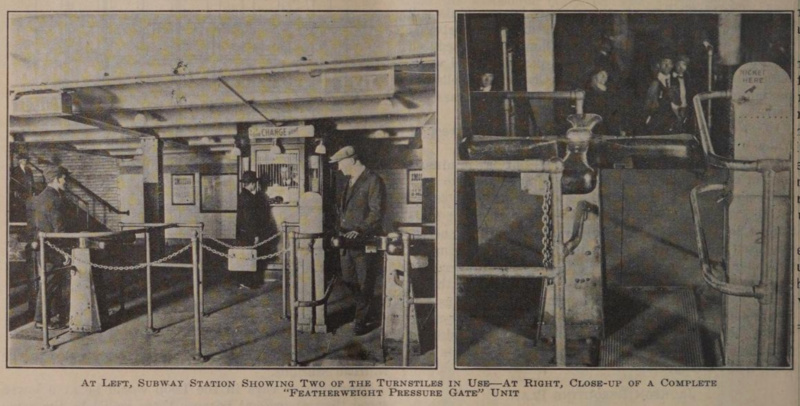
Riders used nickels to get through the first turnstiles. New models were unveiled at the World’s Fair in 1939-40 and the three-arm models were introduced in the 1950s. Subway tokens were also introduced in the 1950s.
The Transit Museum has a display of “slugs”—also known as “washers”—fake coins used as counterfeit subway tokens. Slugs became so mainstream that they ascended to the zeitgeist of the 1990s, featured in the “Baby Shower” episode of Seinfeld. In the show, Kramer suggests Jerry hire a Russian immigrant who sells “slugs” to help him steal cable television. Subway token black markets emerged, forcing the MTA to keep redesigning the subway token, abandoning its signature “Y token” for more sophisticated designs.
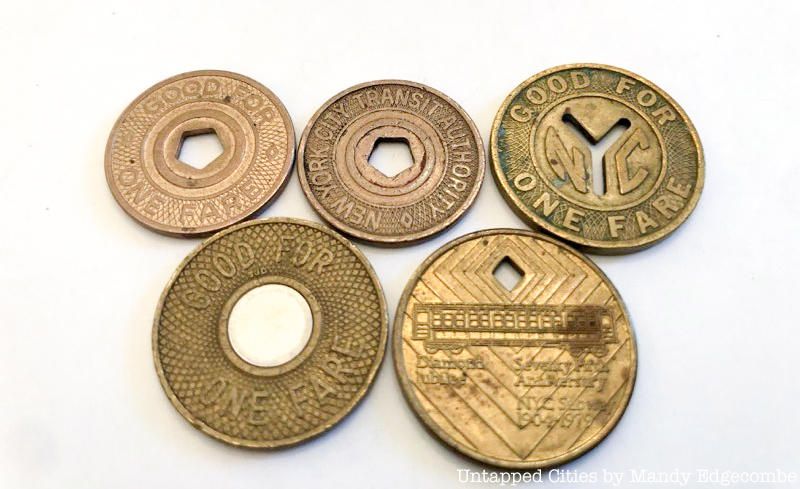
“Token Sucking” was a common practice in the 1980s. This involved stuffing turnstiles with paper or cardboard to purposely jam the machine. After riders inserted their tokens but failed to gain access through the turnstile, they would wander off to report the malfunction to an MTA worker. At that moment, a vigilante would appear. In violation of probably every CDC guideline in the book, the perpetrator would do their best impression of Kirby from Super Smash Bros. and inhale the token from the machine. Token sucking became so prevalent that officers resorted to spraying turnstile slots with mace.
Today’s turnstile dates back to 1994. MetroCards were introduced that year, using technology to communicate with the station terminal and a computer in the booth. You may have spotted the latest advancement in turnstile—“Fare Gates”—at ten stations across the city including the 125th Street station in Harlem and the Port Authority Bus Terminal. Designed to curb turnstile hopping, the gates are a product of the MTA’s “fare evasion lab.” Instead of a turnstile mechanism, these fare gates have doors that are more difficult to climb over.
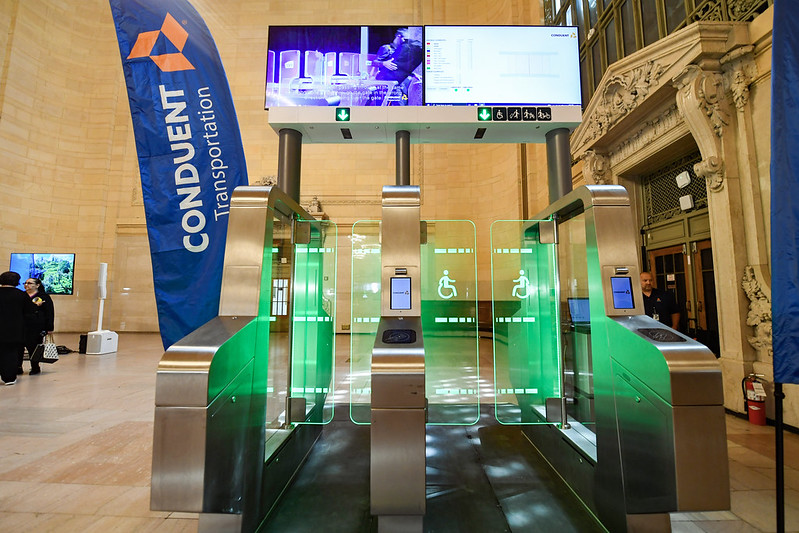
The MTA has hired a “behaviorist” to study the psychology of the fare evader, conceding that evasion is not just a crime of opportunity but “an existential challenge.” But this expert didn’t find anything that wasn’t obvious to the everyday commuter.
The Blue Ribbon report breaks evaders into five archetypes: the opportunistic evader, the frustrated evader, the economically stressed evader, the student evader, and the determined evader. The MTA suggested tailoring its response strategies depending on the assailant. For the opportunistic evader, the MTA will hire security guards to man the emergency gates; for the economically stressed evader, the MTA suggested increasing the income threshold to qualify for the “fare fair” subsidy requirement which gives low-income riders a 50% discount. The subsidy is not actually distributed by the MTA but by the Human Resources Administration, a city-operated agency. The HRA’s new program—which increases the income threshold to 140% of the national poverty level—still falls short of the 200% benchmark that transit activists have been pursuing for the last decade.
Fare evasion has become more mainstream, moving beyond the shady underworld it used to inhabit. Subway fares have increasingly become more expensive over the years. Even when accounting for inflation, today’s subway fare is still nearly twice as expensive as it was throughout the twentieth century. While incremental changes from $2.75 to $2.90 don’t seem like much, it can be a major blow for low-income riders. The fare evasion epidemic is a direct consequence of this “subway-flation.”
The MTA’s surveillance has not gone full 1984, assigning social credit scores to passengers who misbehave. But the Adams’ administration has made a concerted effort to beef up its police presence on public transit by increasing spending on police in subway terminals from $4 million to $155 million in 2023. While this initiative was not entirely devoted to fare evasion, it’s not a coincidence that its launch immediately followed the Blue Ribbon Report.
This enforcement has required more manpower than the NYPD can spare. The Adams administration has hired private security teams to monitor petty crimes like fare evasion. The MTA’s “Eagle Teams,” teams of private officers who sweep MTA buses to verify each passenger’s proof of payment, are a product of the Blue Ribbon Panel Report. These teams have been scattered across the five boroughs, targeting the city’s bus lines, where nearly half of passengers don’t pay to ride.
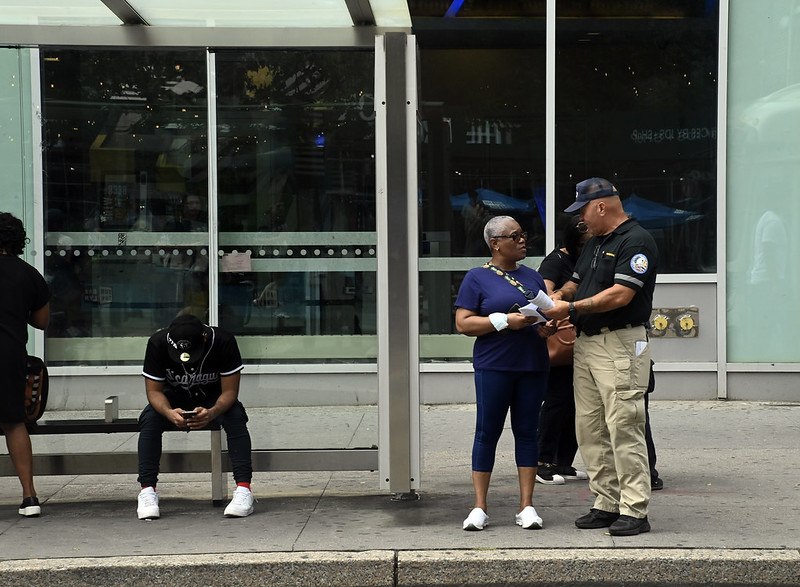
I had the pleasure of running into one of these teams on my daily commute, riding the M60 between the Upper West Side and Harlem. The team boarded the bus like a DEA sting operation, issuing summonses and accosting passengers. Along with some of my fellow riders, I was slapped with a $100 ticket and instructed to disembark the bus and wait for the next one. I decided to take a miserable walk of shame instead, contemplating the MTA’s sad state of affairs.
Our founder Michelle Young had a similar experience: “I was also stopped on the M60 bus to LaGuardia Airport. I had my ticket for the SBS but I couldn’t find it. I opened my suitcase on the sidewalk to search for it, which was mortifying. However, I found it in the end!”
New York has the slowest bus system in America, a fact I learned while speaking with Danny Pearlstein, President of the Riders Alliance, an organization of transit activists who consulted on the city’s Blue Ribbon Report. Pearlstein is currently promoting the Better Bus Initiative, a fight that is especially timely as the city will discontinue its free bus pilot program later this year. The pilot offered one free bus line in each borough.
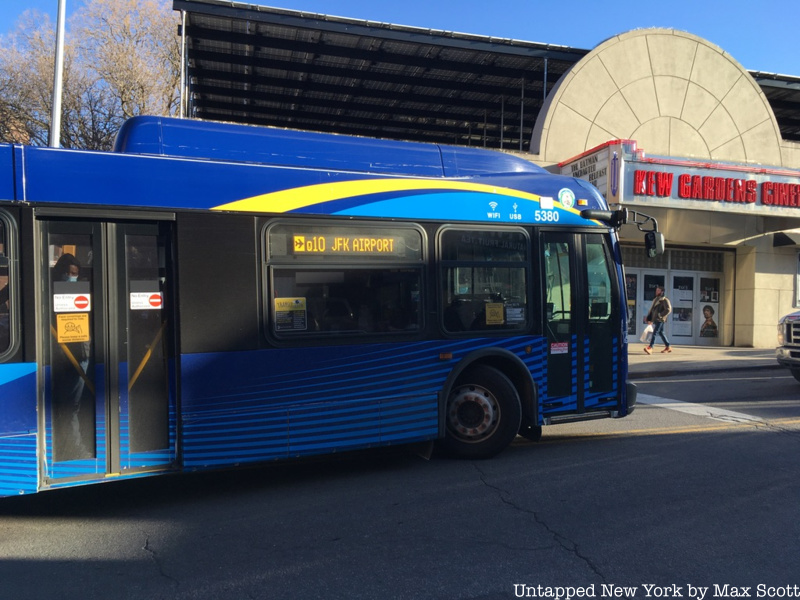
Pearlstein argues that the MTA’s “precision policing” is simply an offshoot of “broken windows,” a policy that unfairly targets Black and Brown riders for petty offenses. The NYPD released a public dataset on all of the fare evasion tickets and summonses it has distributed. The Community Service Society sifted through this data, exposing the MTA’s false narrative that monitoring fare evasion can curb violent crime rates. Their spatial analysis revealed that the NYPD was disproportionately targeting the outer boroughs and three times more likely to issue a fare evasion ticket in a Black neighborhood with a 25% poverty level than in a white neighborhood below this threshold. The most ticketed subway stations, with respect to foot traffic, were Beach 44th, Beach 60th, and Beach 90th, all off the A train in the Rockaways. In reverting to the “broken windows” rhetoric of the Giuliani era, the MTA seems to be stuck in the “token-sucking” days of the 1990s.
The Blue Ribbon Report seemed to come to the same conclusion as most New Yorkers: fare evaders are not conniving freeloaders. However, transit activists argue that the report ignores the agency’s complicity in the fare evasion epidemic. As the MTA rolls back its free bus initiative—and ramps up its policing of subway terminals—it’s unclear whether the report’s conclusions will be substantiated by action.
If the MTA wants to permanently seal the annual hole in its budget that fare evasion induces, it needs to address the obvious culprit: the lack of affordability. Bringing the minimum threshold to qualify for the “fair fare” program to 200% of the poverty level is a start. But it only gets New York on a level playing field with its contemporaries, like Chicago and San Francisco.
Cities like Boston have implemented permanent free bus initiatives, which have not only made transit more equitable but also alleviated strains on its metro system. More importantly, it has eased the burden on low-income riders, saving bus riders in the Boston area from $6 million in fare expenses.
The Adams’ administration has cited several high-profile crimes to justify deploying more officers in subway terminals. But fare evaders are the ones really paying the price of that surveillance. Until public transit is discussed as a basic human right, fare evasion will continue to be the scapegoat for the MTA’s financial woes. Rather than conflating fare evasion with violent crime, fare evasion should be approached as a crisis of affordability, just like housing instability and food insecurity.
Next, check out Secrets of the NYC Subway
Subscribe to our newsletter